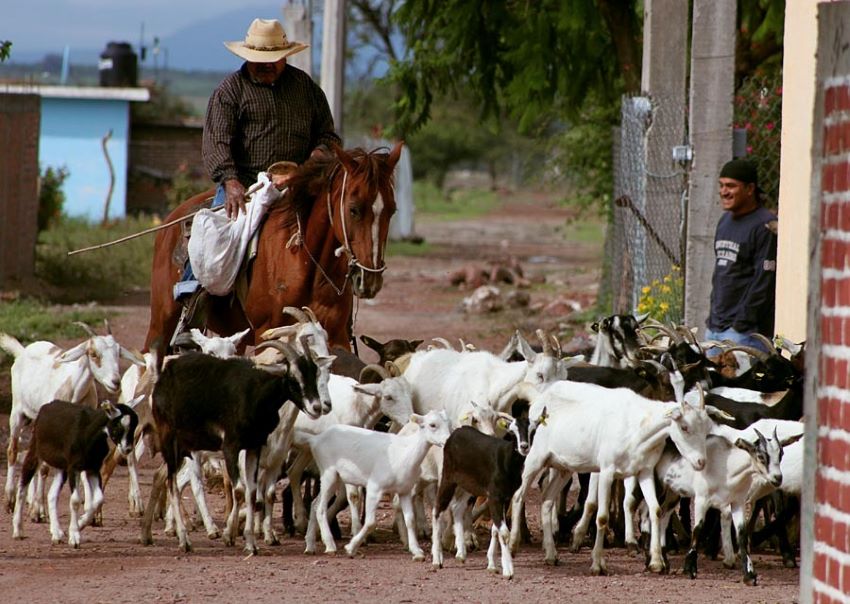Not exactly vegetarian-friendly, the north of Mexico loves meat cooked over a fire.
Such images of vaqueros (cowboys) cooking over open fires lead some culinary experts to think that there is nothing here to offer, but they are wrong.
Perhaps the best example of a deceptively simple food is roasted or grilled goat. It is to Monterrey what barbecue is to the southern United States and sausages to Germany. No visit is complete without trying it.
The most common name for the dish is simply cabrito (little goat), but more descriptive are names like cabrito asado (grilled goat) or cabrito al pastor (shepherd’s-style goat). Like tacos al pastor, the meat is traditionally cooked over a flame in a semi-upright position; the similarity ends there.
The dish in Mexico goes back about 450 years to the early colonial period. The Spanish crown sent unwanted Jews, as well as Portuguese and Arabs to settle this desolate and, frankly, dangerous area. These peoples brought with them their Mediterranean tastes for lamb, goat and spices such as oregano. In fact, today, Nuevo León is the most important producer of oregano in Mexico.

Simply put, cabrito is a kid, in the original sense of the word, that has never been weaned before it is slaughtered. The carcass is sold in markets such as Mercado Juárez in the historic center of Monterrey and usually weighs about 10 kilos. It’s often sold whole and trussed, with the innards removed.
It is a simple preparation, but most regios (residents of Monterrey) jealously guard their recipes and cooking techniques. The goat is soaked in a brine both to hydrate and salt it. Purists insist this brine has only water and salt, but there are cooks who also add cumin and/or pepper. The animal is then trussed on a metal spit to lay flat, much like a spatchcocked chicken.
The most traditional way to cook cabrito is to jam the long end of the spit into the ground at an angle such that the meat hovers over a mound of hot mesquite coals. This technique requires four hours of cooking time and that the meat be turned frequently to avoid hot spots.
Along with whole goats, it is not unusual to see other spits with “stuff” wrapped around the cooking end. These wrapped bundles are called machitos, innards such as the liver and heart wrapped in the stomach and/or intestines and cooked the same way as the rest of the goat. The kidney, with its high fat content, is particularly prized. North of the border, machitos are called “Texas haggis” and, like a lot of things many people won’t eat, are said to be an aphrodisiac.
There are plenty of places that make cabrito in this manner, but modern living can make such cooking impractical. One alternative is to cook the goat in a special oven instead, one made from adobe in an igloo shape. This innovation has led to another name for the dish, cabrito al ataúd (coffin goat).
Diners usually select the part of the goat they want, very much like ordering chicken. The meat is pulled off the bone and eaten in tacos, generally accompanied by red salsa and frijoles borrachos (drunk beans). Monterrey is both corn and flour tortilla country, so it is likely you will be asked which you prefer. Cold beer is recommended for washing it down.

The al pastor name comes from the fact that this was the food of shepherds, who often ate the excess males born to nanny goats.
Over time, it became popular in markets and weekend roadside stands much the way that barbacoa is in the center of Mexico and birria is in Jalisco. Some market stalls that sold the fresh meat exclusively, like El Pipiripau in Mercado Juárez, started serving cooked meat, starting the dish’s popularity in the city.
Cabrito has become something of a mania in Monterrey, with full sit-down restaurants specializing in it. Most of these, of course, claim to have the best in town. Well-known restaurants include El Pastor, Los Principales, El Rey del Cabrito (with three locations), and El Tío, which was the first of its kind.
Most of the cabrito raised in Nuevo León comes from small farms south of Monterrey, but these small producers cannot come anywhere close to meeting the demand. About 1 million goats are eaten here each year, so animals are brought in from all over the north of the country.
Although by far associated with Monterrey, the eating of cabrito extends west into Coahuila and as far as Baja California, although availability may be spotty. Because of migration, the dish can also be found outside of its home range, especially in Mexico City.

Although cabrito al pastor is the most popular goat dish, it is not the only traditional preparation. For example, the cabrito may be stuffed with a mixture of rice, saffron, raisins and nuts, showing its Mediterranean and Sephardic heritage.
Cabrito en salsa is cooked with tomatoes, onions, garlic, serrano chiles, oregano, cumin and bay leaf.
For the more adventurous, there is frittata de cabrito and cuajitos de cabrito. Both are preparations of goat meat, using tomatoes, tomatillos and spices, but both include goat blood as an important ingredient.
Leigh Thelmadatter arrived in Mexico 17 years ago and fell in love with the land and the culture. She publishes a blog called Creative Hands of Mexico and her first book, Mexican Cartonería: Paper, Paste and Fiesta, was published last year. Her culture blog appears weekly on Mexico News Daily.
